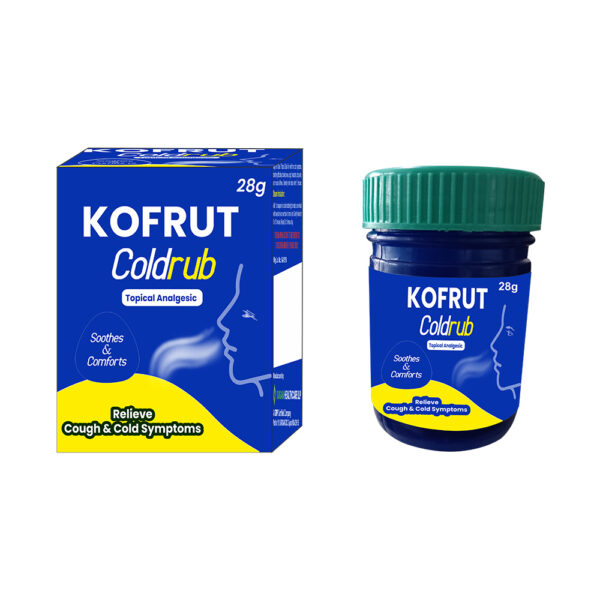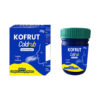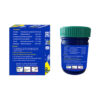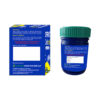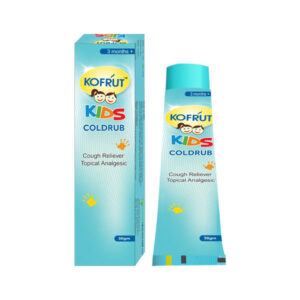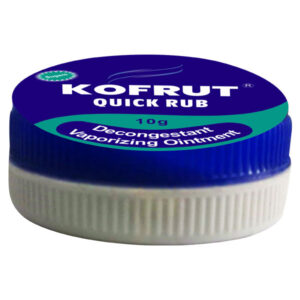Composition :
| Camphor (Cinnamomum camphora) | 5.50%w/w |
Extract derived from
| Menthol (Menthapiperita) | 3.00%w/w |
| Eucalyptus oil (Eucalyptus globulus) | 1.15%w/w |
| Turpentine Oil (PinusLongifolia) | 4.53%w/w |
| Thymol (Trachymspermumammi) | 0.11%w/w |
| Nutmeg Oil (Myristicafragrans) | 0.54%w/w |
Excipients
Flavoured Syrup Base
Sodium Benzoate
Sodium Methyl Paraben
Sodium Propyl Paraben
Colour : Quinoline yellow supra & Brilliant Blue FCF QS
Pharmacology
Pharmacological Properties of the Ingredients:
- Camphor (Cinnamomum camphora): Camphor works as a decongestant and cough suppresant. Camphor rubbing over the skin is most effective in relieving night cough, congestion, and sleep difficulty in children with upper respiratory tract infections.
- Menthol (PudinaSatva): Mint, also known as Mint, has analgesic, astringent, anti -edematous and distracting properties. It is used for the rapid elimination of symptoms of colds.
- Eucalyptus Oil (Eucalyptus globulus): The popular rub is applied to the chest and throat to relieve cough symptoms from the common cold or flu. Eucalyptus Oil can not only silence a cough, it can also help you get the muscus out of your chest. Inhaling vapo rs made with the essential oil can loosen muscus so that when you do cough, it’s expelled. Using a rub containning eucalyptus oil will produce the same effect.
-
Turpentine Oil (PinusLongifolia): Turpentine oil, when inhaled, may help reduce congestion. When used on the skin, turpentine oil may cause warmth and redness that can help relieve pain in the tissue undernath.
-
Thymol (Trachyspermumammi): The thymol content in thyme oil is thought to have antispasmodic properties. Tthyme essential oil has been shown to be effective in reducing coughs and reducing the duration of respiratory tract infections, such as the common cold.
-
Nutmeg Oil (Myristicafragrans): Nutmeg essential oil is beneficial in treat respiratory ailments. For the same reasons as well as its anti – inflammatory properties, nutmeg essential oil can also be used for asthma symptom relief.
Indications :
Kofrut cold rub of product Ayurvedic excellent herbal emery for eliminating nasal congestion, colds and congestion.
When used properly, the drug eliminates the symptoms of colds, such as congestion of the respiratory tract and sinuses, pain in the throat, cough, headaches, and pain throughout the body. ”.
For rapid elimination of nasal congestion and symptoms of colds Kofrut cold rub of colds can be applied in the form of steam inhalations.
Steam inhalations Kofrut cold rub plant from colds contribute.
Contraindications :
Increased sensitivity to any ingredient in the product.
Pregnancy and lactation :
Because of its pure and natural origin, Kofrut Syrup is safe if used therapeutically in pregnant women and to nursing mother. However, it should be used with caution and under medical supervision during pregnancy and lactation.
Warnings and Precautions
In severe uncontrolled diabetes, Kofrut syrup should be taken only after consulting physician, as these are prepared in a sugary base.
Adverse effects
Being an herbal product, Kofrut Syrup is not reported to exert any adverse effects.
Dosage and administration
Adults: 1-2 teaspoonfuls thrice a day
Children: ½-1 teaspoonful thrice a day OR as advised by the Physician
Shake well before use.
Dosage and Method of application :
In case of colds, In case of congestion of the nose and respiratory tract, bopaiah in grouped, kasyap and bop on the whole body Kofrut cold rub of the common cold Mangakomi movements.
In case of colds, In case of congestion of the nose and respiratory tract, bopaiah in grouped, kasyap and bop on the whole body Kofrut cold rub of the common cold Mangakomi movements.
Overdose
In case of accidental overdosage, supportive treatment should be employed.
Presentation
Bottle of 100ml
Shelflife :
36 months
Storage :
Store in a cool & dry place away
From sunlight at a temperature below 25 C
at a place away from reach of children
References
1.IndianJPhysio! Pbannacol2000Jan;44(1):75-81
2.IntJPharm 2000 Mar 20; 197(1-2):213-20
3.
Treatise oflntemal Medicine by Charak
4. Jpn JMed Sci Biol 1990 Jun;43(3):95-100
5.CancerRes l996Mar l;56(5):1023-30
6.AnnitalMedlnt20000ct-Dec;15(4):296-300
7.Farrnakol
Toksikol 1988Jul-Aug;51(4):90-3
8.IntJMo!Med2000Nov;6(5):521-6; Lipids 1998Dec;33(12):1223-8
9. ActaPhysio! Scand.1973Aug;88(4):469-8
10. Nadkarni et.al., IndianMateriaMedica 11. PlantaMed1995Aug;61(4):307-12
12.JEthnophannacol l9960ct;54(1):19-26
13.JEthnophannacol l987Nov;21(2):153-63
14.JPharmPbannacol.1993 Jun;45(6):581-4
15.JEthnophannacol2001 Feb;74(2):133-40
16.www.indianetzone.com
17.www.planetayurveda.com

